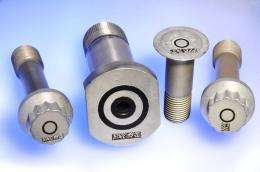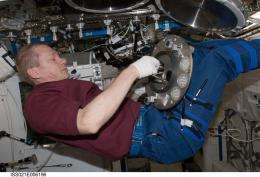Space sensor makes bolts smarter

Technology developed for the International Space Station and a Mars rover is helping European auto-parts manufacturers to engineer lighter, stronger and safer drivetrains and axles.
Bolts are the manufacturing world’s unsung heroes. If two parts aren’t welded together, there’s probably a bolt at work and an engineer figuring out how tight it needs to be. Stretch it too much and it might damage the parts. Too loose, it may wiggle.
Using space-sensor technology, German company Intellifast has created a bolt with an internal sensor to measure the stress while the bolt is in place.
MST Aerospace, the technology broker of ESA’s Technology Transfer Program, helped Intellifast to work with ZF Lemförder, who builds components for the automotive industry.
Now these bolts with ‘space tech inside’ are being used to make better cars.
The art of tightening bolts
Traditionally, a torque wrench is used to tighten bolts to the required degree. Ultrasound has also been used, shooting sonic waves through bolts. The reflected signals reveal how much they are stretched, but the drawback is you need to use a liquid.
“If you want to do an ultrasound scan on your pregnant wife, you have to put glycerin on her belly,” says Intellifast engineer Frank Scheuch. “If you want to do an ultrasound on a bolt, you have to put a coupling liquid on the bolt and use a handheld sensor.”
But relying on technicians to apply the liquid properly and hold the sensor correctly isn’t good enough for many applications. “If you measure five times with the same person, you get five different readings,” explains Scheuch.
Add in the complexity of accessing bolts in, say, fighter jets or offshore wind turbines and it is clear a more reliable solution is needed.
Space had the answer
Developed for the International Space Station's Material Science Laboratory, Intellifast uses a small ultrasonic sensor mounted in the bolt’s head.
A technician attaches a meter to perform an ultrasound sweep and measure the strain on the bolt. The meter can also be attached to the torque wrench so the bolt’s condition can be tracked even as it is screwed into place.

The same approach was used on NASA’s Mars Pathfinder rover.
With torque wrenches or ultrasound, bolt tightening could be off by as much as 30% of the bolt’s true strength, resulting in over-sized and heavier bolts to ensure they hold.
In space and aviation this can be extremely costly. By precisely measuring a bolt load it can be lighter and still be within a safe margin of error – 3%, according to Scheuch.
Now designers use PMT bolts in their search for lighter cars. “In some cases, we really do have to know the exact clamp load,” says ZF Lemförder engineer Ferry Oude Kotte.
“The really good thing about Intellifast’s solution is we don’t have to alter the connection itself to conduct tests. The result is better, safer cars made possible with bolt-technology developed for space.”
Provided by European Space Agency



















